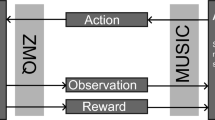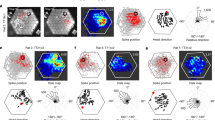Abstract
Classic studies have shown that place cells are organized along the dorsoventral axis of the hippocampus according to their field size, with dorsal hippocampal place cells having smaller field sizes than ventral place cells. Studies have also suggested that dorsal place cells are primarily involved in spatial navigation, while ventral place cells are primarily involved in context and emotional encoding. Additionally, recent work has shown that the entire longitudinal axis of the hippocampus may be involved in navigation. Based on the latter, in this paper we present a spatial cognition reinforcement learning model inspired by the multiscale organization of the dorsal–ventral axis of the hippocampus. The model analyzes possible benefits of a multiscale architecture in terms of the learning speed, the path optimality, and the number of cells in the context of spatial navigation. The model is evaluated in a goal-oriented task where simulated rats need to learn a path to the goal from multiple starting locations in various open-field maze configurations. The results show that smaller scales of representation are useful for improving path optimality, whereas larger scales are useful for reducing learning time and the number of cells required. The results also show that combining scales can enhance the performance of the multiscale model, with a trade-off between path optimality and learning time.


















Similar content being viewed by others
References
Abdi H (2007) Bonferroni and Šidák corrections for multiple comparisons. Encycl Meas Stat 3:103–107
Bellocchio F, Ferrari S, Piuri V, Borghese NA (2007) Online training of Hierarchical RBF. In: IEEE International conference on neural networks—conference proceedings, pp 2159–2164. https://doi.org/10.1109/IJCNN.2007.4371292. ISSN 10987576
Chen LL, Lin LH, Green EJ, Barnes CA, McNaughton BL (1994) Head-direction cells in the rat posterior cortex—I. Anatomical distribution and behavioral modulation. Exp Brain Res. https://doi.org/10.1007/BF00243212. ISSN 00144819
Contreras M, Pelc T, Llofriu M, Weitzenfeld A, Fellous JM (2018) The ventral hippocampus is involved in multi-goal obstacle-rich spatial navigation. Hippocampus. https://doi.org/10.1002/hipo.22993. ISSN 10981063
de Almeida L, Idiart M, Lisman JE (2009) The input–output transformation of the hippocampal granule cells: from grid cells to place fields. J Neurosci. https://doi.org/10.1523/jneurosci.6048-08.2009. ISSN 0270-6474
de Hoz L, Knox J, Morris RG (2003) Longitudinal axis of the hippocampus: both septal and temporal poles of the hippocampus support water maze spatial learning depending on the training protocol. ISSN 10509631
Dijkstra EW (1959) A note on two problems in connexion with graphs. Numer Math 1(1):269–271
Dinno A (2017) Package ’dunn. test’: Dunn’s test of multiple comparisons using rank sums. R package version 1(4)
Erdem UM, Hasselmo M (2012) A goal-directed spatial navigation model using forward trajectory planning based on grid cells. Eur J Neurosci. https://doi.org/10.1111/j.1460-9568.2012.08015.x. ISSN 0953816X
Erdem UM, Hasselmo ME (2014) A biologically inspired hierarchical goal directed navigation model. J Physiol Paris 108(1):28–37. https://doi.org/10.1016/j.jphysparis.2013.07.002. ISSN 09284257
Fan C, Chen Z, Jacobson A, Hu X, Milford M (2017) Biologically-inspired visual place recognition with adaptive multiple scales. Robot Auton Syst 96:224–237. https://doi.org/10.1016/j.robot.2017.07.015 ISSN 09218890
Fanselow MS, Dong H-W (2010) Are the dorsal and ventral hippocampus functionally distinct structures? Neuron. https://doi.org/10.1016/j.neuron.2009.11.031. ISSN 1097-4199
Ferrari S, Frosio I, Piuri V, Borghese NA (2005) Automatic multiscale meshing through HRBF networks. IEEE Trans Instrum Meas. https://doi.org/10.1109/TIM.2005.851471. ISSN 00189456
Fyhn M, Molden S, Witter MP, Moser EI, Moser MB (2004) Spatial representation in the entorhinal cortex. Science. https://doi.org/10.1126/science.1099901. ISSN 00368075
Garthe A, Kempermann G (2013) An old test for new neurons: refining the morris water maze to study the functional relevance of adult hippocampal neurogenesis. ISSN 16624548
Guazzelli A, Bota M, Corbacho FJ, Arbib MA (1998) Affordances, motivations, and the world graph theory. Adapt Behav. https://doi.org/10.1177/105971239800600305. ISSN 10597123
Hafting T, Fyhn M, Molden S, Moser MB, Moser EI (2005) Microstructure of a spatial map in the entorhinal cortex. Nature. https://doi.org/10.1038/nature03721. ISSN 00280836
Harland B, Contreras M, Fellous JM (2017) A role for the longitudinal axis of the hippocampus in multiscale representations of large and complex spatial environments and mnemonic hierarchies. In: The hippocampus-plasticity and functions. IntechOpen
Hoydal OA, Skytoen ER, Moser M-B, Moser EI (2018) Object-vector coding in the medial entorhinal cortex. bioRxiv, p 286286. https://doi.org/10.1101/286286. ISSN 1476-4687. https://www.biorxiv.org/content/early/2018/03/22/286286
Jadhav SP, Kemere C, German PW, Frank LM (2012) Awake hippocampal sharp-wave ripples support spatial memory. Science. https://doi.org/10.1126/science.1217230. ISSN 10959203
Johnson A, Redish AD (2007) Neural ensembles in CA3 transiently encode paths forward of the animal at a decision point. J Neurosci Off J Soc Neurosci. https://doi.org/10.1523/JNEUROSCI.3761-07.2007. ISSN 1529-2401
Jung MW, Wiener SI, McNaughton BL (1994) Comparison of spatial firing characteristics of units in dorsal and ventral hippocampus of the rat. J Neurosci 14(12):7347–7356
Kjelstrup KB, Solstad T, Brun VH, Hafting T, Leutgeb S, Witter MP, Moser EI, Moser MB (2008) Finite scale of spatial representation in the hippocampus. Science. https://doi.org/10.1126/science.1157086. ISSN 00368075
Kretchmar RM, Anderson CW (1997) Comparison of CMACs and radial basis functions for local function approximators in reinforcement learning. In: IEEE International conference on neural networks—conference proceedings, vol 2, October 2014, pp 834–837. https://doi.org/10.1109/ICNN.1997.616132. ISSN 10987576
Krzywinski M, Altman N (2014) Points of significance. Nature Publishing Group, Berlin, Visualizing samples with box plots
Leonard TK, Mikkila JM, Eskandar EN, Gerrard JL, Kaping D, Patel SR, Womelsdorf T, Hoffman KL (2015) Sharp wave ripples during visual exploration in the primate hippocampus. J Neurosci. https://doi.org/10.1523/jneurosci.0864-15.2015. ISSN 0270-6474
Lever C, Burton S, Jeewajee A, O’Keefe J, Burgess N (2009) Boundary vector cells in the subiculum of the hippocampal formation. J Neurosci. https://doi.org/10.1523/jneurosci.1319-09.2009. ISSN 0270-6474
Llofriu M, Tejera G, Contreras M, Pelc T, Fellous JM, Weitzenfeld A (2015) Goal-oriented robot navigation learning using a multi-scale space representation. Neural Netw 72:62–74. https://doi.org/10.1016/j.neunet.2015.09.006. ISSN 18792782
Llofriu M, Scleidorovich P, Tejera G, Contreras M, Pelc T, Fellous J-M, Weitzenfeld A (2019) A computational model for a multi-goal spatial navigation task inspired in rodent studies. In: IJCNN
Lozano-Pérez T, Wesley MA (1979) An algorithm for planning collision-free paths among polyhedral obstacles. Commun ACM. https://doi.org/10.1145/359156.359164. ISSN 00010782
Lyttle D, Gereke B, Lin KK, Fellous JM (2013) Spatial scale and place field stability in a grid-to-place cell model of the dorsoventral axis of the hippocampus. Hippocampus 23(8):729–744. https://doi.org/10.1002/hipo.22132. ISSN 10509631
Maurer AP, VanRhoads SR, Sutherland GR, Lipa P, McNaughton BL (2005) Self-motion and the origin of differential spatial scaling along the septo-temporal axis of the hippocampus. Hippocampus. https://doi.org/10.1002/hipo.20114. ISSN 10509631
McNaughton BL, Barnes CA, Gerrard JL, Gothard K, Jung MW, Knierim JJ, Kudrimoti H, Qin Y, Skaggs WE, Suster M, Weaver KL (1996) Deciphering the hippocampal polyglot: the hippocampus as a path integration system. J Exp Biol 199(1):173–185
Muller R, Kubie J (1987) The effects of changes in the environment on the spatial firing of hippocampal complex-spike cells. J Neurosci. https://doi.org/10.1523/jneurosci.07-07-01951.1987. ISSN 0270-6474
O’Keefe J, Burgess N (1996) Geometric determinants of the place fields of hippocampal neurons. Nature. https://doi.org/10.1038/381425a0. ISSN 00280836
O’Keefe J, Dostrovsky J (1971) The hippocampus as a spatial map. Preliminary evidence from unit activity in the freely-moving rat. Brain Res. https://doi.org/10.1016/0006-8993(71)90358-1. ISSN 00068993
O’Keefe J, Nadel L (1978) The hippocampus as a cognitive map. Oxford University Press, Oxford
Pfeiffer BE, Foster DJ (2013) Hippocampal place-cell sequences depict future paths to remembered goals. Nature. https://doi.org/10.1038/nature12112. ISSN 1476-4687
Poppenk J, Evensmoen HR, Moscovitch M, Nadel L (2013) Long-axis specialization of the human hippocampus. ISSN 13646613
Pouderoux J, Gonzato J-C, Tobor I, Guitton P (2004) Adaptive hierarchical RBF interpolation for creating smooth digital elevation models. In: Proceedings of the 12th annual ACM international workshop on Geographic information systems, pp. 232–240. https://doi.org/10.1145/1032222.1032256
Rivard B, Li Y, Lenck-Santini P-P, Poucet B, Muller RU (2004) Representation of objects in space by two classes of hippocampal pyramidal cells. J Gen Physiol. https://doi.org/10.1085/jgp.200409015. ISSN 0022-1295
Savelli F, Yoganarasimha D, Knierim JJ (2008) Influence of boundary removal on the spatial representations of the medial entorhinal cortex. Hippocampus. https://doi.org/10.1002/hipo.20511. ISSN 10509631
Solstad T, Boccara CN, Kropff E, Moser M-B, Moser EI (2008) Representation of geometric borders in the entorhinal cortex. Science. https://doi.org/10.1126/science.1166466. ISSN 0036-8075
Strange BA, Witter MP, Lein ES, Moser EI (2014) Functional organization of the hippocampal longitudinal axis. ISSN 14710048
Sutton RS, Barto AG (2018) Reinforcement learning: an introduction. MIT Press, Cambridge. ISBN 9780262039246
Sutton R, Mcallester D, Singh S, Mansour Y (2000) Policy gradient methods for reinforcement learning with function approximation. NIPS. AT&T Labs - Research, Florham Park. https://doi.org/10.1177/004728757601400384. ISSN 0047-2875
Taube JS, Muller RU, Ranck JB (1990) Head-direction cells recorded from the postsubiculum in freely moving rats. I. Description and quantitative analysis. J Neurosci Off J Soc Neurosci. https://doi.org/10.1212/01.wnl.0000299117.48935.2e. ISSN 0270-6474
Vorhees CV, Williams MT (2006) Morris water maze: Procedures for assessing spatial and related forms of learning and memory. Nat Protoc. https://doi.org/10.1038/nprot.2006.116. ISSN 17542189
Acknowledgements
This work is being funded by NSF IIS Robust Intelligence Research Collaboration Grant #1703340 at the University of South Florida and the University of Arizona entitled “Experimental and Robotics Investigations of Multi-Scale Spatial Memory Consolidation in Complex Environments”.
Author information
Authors and Affiliations
Corresponding author
Additional information
Communicated by Jean-Marc Fellous.
Publisher's Note
Springer Nature remains neutral with regard to jurisdictional claims in published maps and institutional affiliations.
This article is part of the Special Issue entitled ‘Complex Spatial Navigation in Animals, Computational Models and Neuro-inspired Robots’.
Rights and permissions
About this article
Cite this article
Scleidorovich, P., Llofriu, M., Fellous, JM. et al. A computational model for spatial cognition combining dorsal and ventral hippocampal place field maps: multiscale navigation. Biol Cybern 114, 187–207 (2020). https://doi.org/10.1007/s00422-019-00812-x
Received:
Accepted:
Published:
Issue Date:
DOI: https://doi.org/10.1007/s00422-019-00812-x




